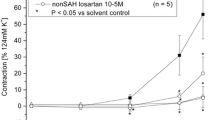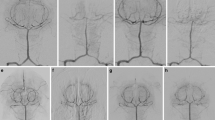Abstract
Background
Under physiological cerebral conditions, levosimendan, a calcium-channel sensitizer, has a dose-dependent antagonistic effect on prostaglandin F2alpha (PGF)-induced vasoconstriction. This circumstance could be used in antagonizing delayed cerebral vasospasm (dCVS), one of the main complications after subarachnoid hemorrhage (SAH), leading to delayed cerebral ischemia and ischemic neurological deficits. Data already exist that identified neuroprotective effects of levosimendan in a traumatic brain injury model and additionally, it has been proven that this compound prevents narrowing of the basilar artery (BA) luminal area after SAH in an in vitro rabbit model. Takotsubo cardiomyopathy, a severe ventricular dysfunction, is also a well-known complication after SAH, associated with pulmonary edema and prolonged intubation.
Methods
The polypeptide endothelin-1 (ET-1) plays a key role in the development of dCVS after SAH. Therefore, the aim of the present investigation was to detect functional interactions between the calcium-sensitizing and the ET-1-dependent vasoconstriction after experimental-induced SAH; interactions between levosimendan and a substrate-specific vasorelaxation in the BA were also examined. It was reviewed whether levosimendan has a beneficial influence on endothelin(A) and/or endothelin(B1) receptors (ET-(A) and ET-(B1) receptors) in cerebral vessels after SAH. We also examined whether this drug could have antagonistic effects on a PGF-induced vasoconstriction.
Results
Under treatment with levosimendan after SAH, the endothelin system seems to be affected. The ET-1-induced contraction is decreased, not significantly. In addition, we detected changes in the nitric oxide-cyclic guanosine monophosphate (NO-cGMP) pathway. Preincubation with levosimendan causes a modulatory effect on the ET-(B1) receptor-dependent vasorelaxation. It induces an upregulation of the NO-cGMP pathway with a significantly increased relaxation. Even after PGF-induced precontraction a dose-dependent relaxation was registered, which was significantly higher (Emax) and earlier (pD2) compared to the concentration–effect curve without levosimendan.
Conclusions
After experimental-induced dCVS, levosimendan seems to restore the well-known impaired function of the vasorelaxant ET-(B1) receptor. Levosimendan also reversed the PGF-induced contraction dose-dependently. Both of these mechanisms could be used for antagonizing dCVS in patients suffering SAH. Levosimendan could even be used additionally in treating patients developing takotsubo cardiomyopathy.







Similar content being viewed by others
References
Antonini M, Stazi GV, Cirasa MT, Garotto G, Frustaci A (2010) Efficacy of levosimendan in Takotsubo-related cardiogenic shock. Acta Anaesthesiol Scand 54:119–120
Archan S, Toller W (2008) Levosimendan: current status and future prospects. Curr Opin Anaesthesiol 21:78–84
Asaeda M, Sakamoto M, Kurosaki M, Tabuchi S, Kamitani H, Yokota M, Watanabe T (2005) A non-enzymatic derived arachidonyl peroxide, 8-iso-prostaglandin F2 alpha, in cerebrospinal fluid of patients with aneurysmal subarachnoid hemorrhage participates in the pathogenesis of delayed cerebral vasospasm. Neurosci Lett 373:222–225
Budohoski KP, Czosnyka M, Smielewski P, Kasprowicz M, Helmy A, Bulters D, Pickard JD, Kirkpatrick PJ (2012) Impairment of cerebral autoregulation predicts delayed cerebral ischemia after subarachnoid hemorrhage: a prospective observational study. Stroke 43:3230–3237
Busani S, Rinaldi L, Severino C, Cobelli M, Pasetto A, Girardis M (2010) Levosimendan in cardiac failure after subarachnoid hemorrhage. J Trauma 68(5):E108–110
Chen S, Ma Q, Krafft PR, Hu Q, Rolland W 2nd, Sherchan P, Zhang J, Tang J, Zhang JH (2013) P2X7r/cryopyrin inflammasome axis inhibition reduces neuroinflammation after SAH. Neurobiol Dis 58C:298–307
Dreier JP, Drenckhahn C, Woitzik J, Major S, Offenhauser N, Weber-Carstens S, Wolf S, Strong AJ, Vajkoczy P, Hartings JA, COSBID Study Group (2013) Spreading ischemia after aneurysmal subarachnoid hemorrhage. Acta Neurochir Suppl 115:125–129
Figgitt DP, Gillies PS, Goa KL (2001) Levosimendan. Drugs 61:613–627
Fujii M, Yan J, Rolland WB, Soejima Y, Caner B, Zhang JH (2013) Early brain injury, an evolving frontier in subarachnoid hemorrhage research. Transl Stroke Res 4:432–446
Güresir E, Vasiliadis N, Konczalla J, Raab P, Hattingen E, Seifert V, Vatter H (2013) Erythropoetin prevents delayed hemodynamic dysfunction after subarachnoid hemorrhage in a randomized controlled experimental setting. J Neurol Sci 332:128–135
Hansen-Schwartz J (2004) Receptor changes in cerebral arteries after subarachnoid haemorrhage. Acta Neurol Scand 109:33–34
Hein M, Zoremba N, Bleilevens C, Bruells C, Rossaint R, Roehl AB (2013) Levosimendan limits reperfusion injury in a rat middle cerebral artery occlusion (MCAO) model. BMC Neurol 13:106
Jensen H, Eija R, Tuomas M, Jussi M, Fredrik Y, Kirsi A, Matti P, Kai K, Hannu T, Vesa A, Tatu J (2011) Levosimendan decreases intracranial pressure after hypothermic circulatory arrest in a porcine model. Scand Cardiovasc J 45:307–315
Karakus E, Halici Z, Albayrak A, Bayir Y, Aydin A, Unal D, Cadirci E, Ferah I, Odaci E (2013) Beneficial pharmacological effects of levosimendan on antioxidant status of acute inflammation induced in paw of rat: involvement of inflammatory mediators. Basic Clin Pharmacol Toxicol 112(3):156–63
Karvouniaris M, Papanikolaou J, Makris D, Zakynthinos E (2012) Sepsis-associated takotsubo cardiomyopathy can be reversed with levosimendan. Am J Emerg Med 30:832.e5–832.e7
Kassell NF, Peerless SJ, Durward QJ, Beck DW, Drake CG, Adams HP (1982) Treatment of ischemic deficits from vasospasm with intravascular volume expansion and induced arterial hypertension. Neurosurgery 11(3):337–343
Kassell NF, Torner JC, Haley EC Jr, Jane JA, Adams HP, Kongable GL (1990) The international cooperative study on the timing of aneurysm surgery. Part 1: overall management results. J Neurosurg 73:18–36
Katircioglu SF, Seren M, Parlar AI, Turan NN, Manavbasi Y, Aydog G, Cicekcioglu F, Tutun U, Ulus AT (2008) Levosimendan effect on spinal cord ischemia-reperfusion injury following aortic clamping. J Card Surg 23:44–48
Kitazono T, Heistad DD, Faraci FM (1995) Dilatation of the basilar artery in response to selective activation of endothelin-B receptors in vivo. J Pharmacol Exp Ther 273:1–6
Konczalla J, Brawanski N, Bruder M, Senft C, Platz J, Seifert V. (2016) Outcome of Patients with Long-Lasting Cerebral Vasospasm After Subarachnoid Hemorrhage: Is Prolonged Treatment for Cerebral Vasospasm Worthwile? A Matched-Pair Analysis. World Neurosurg 88:488–96
Konczalla J, Mrosek J, Wanderer S, Schuss P, Güresir E, Seifert V, Vatter H, Platz J (2013) Functional effects of levosimendan in rat basilar arteries in vitro. Curr Neurovasc Res 10:126–133
Konczalla J, Vatter H, Weidauer S, Raabe A, Seifert V (2006) Alteration of the cerebrovascular function of endothelin-B receptor after subarachnoidal hemorrhage in the rat. Exp Biol Med (Maywood) 231:1064–1068
Konczalla J, Wanderer S, Mrosek J, Schuss P, Platz J, Güresir E, Seifert V, Vatter H (2013) Crosstalk between the angiotensin and endothelin-system in the cerebrovasculature. Curr Neurovasc Res 10:335–345
Koskinen LO, Olivecrona M, Rodling-Wahlstrom M, Naredi S (2009) Prostacyclin treatment normalises the MCA flow velocity in nimodipine-resistant cerebral vasospasm after aneurysmal subarachnoid haemorrhage: a pilot study. Acta Neurochir (Wien) 151:595–599
Lafci B, Yasa H, Ilhan G, Ortac R, Yilik L, Kestelli M, Goktogan T, Gurbuz A (2008) Protection of the spinal cord from ischemia: comparative effects of levosimendan and iloprost. Eur Surg Res 41:1–7
Mayer SA, Lin J, Homma S, Solomon RA, Lennihan L, Sherman D, Fink ME, Beckford A, Klebanoff LM (1999) Myocardial injury and left ventricular performance after subarachnoid hemorrhage. Stroke 30:780–786
Mayer SA, LiMandri G, Sherman D, Lennihan L, Fink ME, Solomon RA, DiTullio M, Klebanoff LM, Beckford AR, Homma S (1995) Electrographic markers of abnormal left ventricular wall motion in acute subarachnoid hemorrhage. J Neurosurg 83:889–896
Nilsson T, Cantera L, Adner M, Edvinsson L (1997) Presence of contractile endothelin-A and dilatory endothelin-B receptors in human cerebral arteries. Neurosurgery 40:346–351
Padayachee L (2007) Levosimendan: the inotrope of choice in cardiogenic shock secondary to takotsubo cardiomyopathy? Heart Lung Circ 16(Suppl 3):65–70
Papanikolaou J, Tsolaki V, Makris D, Zakynthinos E (2014) Early levosimendan administration may improve outcome in patients with subarachnoid hemorrhage complicated by acute heart failure. Int J Cardiol 176(3):1435–7
Provencio JJ (2013) Inflammation in subarachnoid hemorrhage and delayed deterioration associated with vasospasm: a review. Acta Neurochir Suppl 115:233–238
Roehl AB, Hein M, Loetscher PD, Rossaint J, Weiss J, Roissant R, Coburn M (2010) Neuroprotective properties of levosimendan in an in vitro model of traumatic brain injury. BMC Neurol 10:97
Roehl AB, Zoremba N, Kipp M, Schiefer J, Goetzenich A, Bleilevens C, Kuehn-Velten N, Rossiant R, Hein M (2012) The effects of levosimendan on brain metabolism during initial recovery from global transient ischaemia/hypoxia. BMC Neurol 12:81
Salom JB, Torregrosa G, Alborch E (1995) Endothelins and the cerebral circulation. Cerebrovasc Brain Metab Rev 7:131–152
Santoro F, Ieva R, Ferraretti A, Ienco V, Carpagnano G, Lodispoto M, Di Biase M, Brunetti ND (2013) Safety and feasibility of levosimendan administration in takotsubo cardiomyopathy: a case series. Cardiovasc Ther 31:e133–e137
Schilling L, Feger GI, Ehrenreich H, Wahl M (1995) Endothelin-3-induced relaxation of isolated rat basilar artery is mediated by an endothelial ETB-type endothelin receptor. J Cereb Blood Flow Metab 15:699–705
Seifert V, Loffler BM, Zimmermann M, Roux S, Stolke D (1995) Endothelin concentrations in patients with aneurysmal subarachnoid hemorrhage. Correlation with cerebral vasospasm, delayed ischemic neurological deficits, and volume of hematoma. J Neurosurg 82:55–62
Seifert V, Stolke D, Kaever V, Dietz H (1987) Arachidonic acid metabolism following aneurysm rupture. Evaluation of cerebrospinal fluid and serum concentration of 6-keto-prostaglandin F1 alpha and thromboxane B2 in patients with subarachnoid hemorrhage. Surg Neurol 27:243–252.41
Taccone FS, Brasseur A, Vincent JL, De Backer D (2013) Levosimendan for the treatment of subarachnoid hemorrhage-related cardiogenic shock. Intensive Care Med 39(8):1497–1498
Tung P, Kopelnik A, Banki N (2004) Predictors of neurogenic injury after subarachnoid hemorrhage. Stroke 35:548–551
Vatter H, Konczalla J, Seifert V (2011) Endothelin-related pathophysiology in cerebral vasospasm: what happens to the cerebral vessels? Acta Neurochir Suppl 110:177–180
Vatter H, Konczalla J, Weidauer S, Preibisch C, Zimmermann M, Raabe A, Seifert V (2007) Effect of delayed cerebral vasospasm on cerebrovascular endothelin-A receptor expression and function. J Neurosurg 107:121–127
Vatter H, Konczalla J, Weidauer S, Preibisch C, Raabe A, Zimmermann M, Seifert V (2007) Characterization of the endothelin-B receptor expression and vasomotor function during experimental cerebral vasospasm. Neurosurgery 60:1100–1108
Vatter H, Mursch K, Zimmermann M, Zilliken M, Zilliken P, Kolenda H, Seifert V, Schilling L (2002) Endothelin-converting enzyme activity in human cerebral circulation. Neurosurgery 51:445–451
Vatter H, Weidauer S, Konczalla J, Dettmann E, Zimmermann M, Raabe A, Preibisch C, Zanella FE, Seifert V (2006) Time course in the development of cerebral vasospasm after experimental subarachnoid hemorrhage: clinical and neuroradiological assessment of the rat double hemorrhage model. Neurosurgery 58:1190–1197
Acknowledgments
We thank Marina Heibel for her excellent technical support. Furthermore, we are grateful for the experimental assistance of Dr. A. Theisen.
Author information
Authors and Affiliations
Corresponding author
Ethics declarations
Funding
No funding was received for this research.
Conflict of interest
All authors certify that they have no affiliations with or involvement in any organization or entity with any financial interest (such as honoria; educational grants; participation in speakers’ bureaus; membership, employment, consultancies, stock ownership, or other equity interest; and expert testimony or patent-licensing arrangements), or non-financial interest (such as personal or professional relationships, affiliations, knowledge or beliefs) in the subject matter or materials discussed in this manuscript.
Levosimendan, as already mentioned, was kindly provided by Jouko Levijoki, M. Sc. (Pharm.) from Orion Corporation, Orion Pharma (Espoo, Finland).
Animal experiments
All procedures performed in studies involving animals were in accordance with the ethical standards of the institution or practice at which the studies were conducted.
Additional information
Juergen Konczalla and Stefan Wanderer shared first authorship.
Rights and permissions
About this article
Cite this article
Konczalla, J., Wanderer, S., Mrosek, J. et al. Levosimendan, a new therapeutic approach to prevent delayed cerebral vasospasm after subarachnoid hemorrhage?. Acta Neurochir 158, 2075–2083 (2016). https://doi.org/10.1007/s00701-016-2939-5
Received:
Accepted:
Published:
Issue Date:
DOI: https://doi.org/10.1007/s00701-016-2939-5




